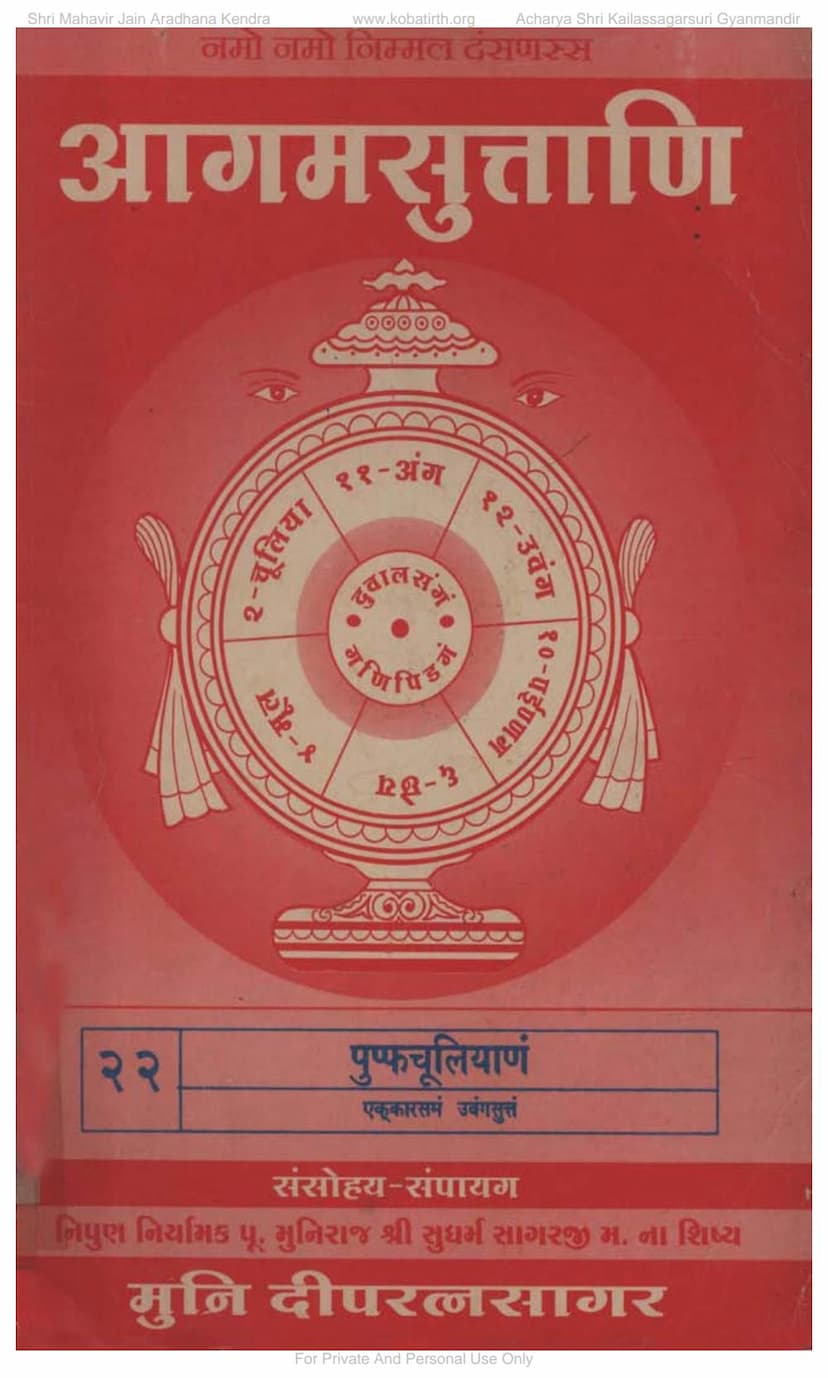Agam 22 Pupphachuliyanam Uvangsutt 11 Moolam
Added to library: September 1, 2025

Summary
Here's a comprehensive summary of the provided Jain text, "Agam 22 Pupphachuliyanam Uvangsutt 11 Moolam," based on the pages you've shared:
Book Title: Agam 22 Pupphachuliyanam Uvangsutt 11 Moolam Author(s): Dipratnasagar, Deepratnasagar Publisher: Agam Shrut Prakashan
Overall Purpose and Content:
This document is a printed edition of a Jain Agam scripture, specifically the Eleventh Upanga Sutra, titled Pushpachulika (or Pupphachuliyanam). It is part of a larger collection of Jain scriptures (Agams) and is presented with a commentary or explanation. The publication emphasizes its dedication to preserving and disseminating Jain teachings.
Key Information and Features:
- Scripture Identification: The text clearly identifies itself as the "Eleventh Upanga Sutra" (एक्कारसमं उवंगसुत्तं) within the Jain canon, specifically the "Pushpachulika" (पुष्पचूलियाणं). It also notes that the Pushpachulika is the fourth section (varga) of the Upanga Sutras.
- Author and Publisher: The work is attributed to Muni Deepratnasagar, a disciple of Muni Sudharma Sagarji Maharaj. The publisher is Agam Shrut Prakashan, with printing details provided for "Namrata Multi-Printing Press" and "Shri Graphics" in Ahmedabad.
- Financial Support and Dedications: A significant portion of the introductory pages (Pages 3-5) lists numerous individuals and families who provided financial support (आर्थिक अनुदान दाता, मुख्य द्रव्य सहायक, आगम-चोर योजना नाभिदातः) for the publication of this and other Agam volumes. These donations are often made in remembrance of parents, spiritual guides, or as a form of religious merit. This highlights the community-driven effort behind such publications.
- Structure of the Text:
- Introduction: The initial pages include traditional Jain invocations (Namō Namō Nirmala Darśanassa, Namō Namō Nirmala Dantamassa, and salutations to gurus).
- Table of Contents/Guidance (Suchanapatra): Page 6 provides crucial instructions on how to read and understand the text:
- Consecutive Numbering: Explains that the first number on the left indicates the combined serial number of the sutra and its stanza (gaha).
- Hindi Numbering: Points to the Hindi numbering on the right for referencing the sutra and stanza numbers as printed in the Agam Sutra Granth.
- Sutra and Gaha Markers: Details how vertical lines ( | ) with numbers in between denote sutras, and double vertical lines (||) with numbers in between denote stanzas.
- English Numbering: Explains the English numbering on the right indicates the corresponding verse/commentary (vritti) number. An 'R' after a number signifies that the sutra or stanza appears a second time in the commentary.
- Square Brackets
[]: Indicates supplementary text or completions of missing parts in the original texts.
- The Pushpachulika Content (Pages 7-9): This section begins the actual text of the Pushpachulika.
- Chapter Structure: It is stated that the Pushpachulika contains ten chapters (अज्झयणाणि - adjhayananis).
- Opening Dialogue: The text starts with a dialogue, likely between Lord Mahavir and his disciple Gautama Swami, discussing the scriptures. It mentions that Lord Mahavir declared ten chapters for the Pushpachulika.
- Narrative Example (Chapter 1): The initial portion details a narrative (likely the first chapter) about a householder named Sudarshana in the city of Rajagriha. His daughter, named Bhuta, expresses a desire to take initiation from Lord Parshva (who was contemporary or prior to Mahavir).
- The Story of Bhuta: Bhuta asks for her parents' permission to become a disciple. After obtaining it, she adorns herself and goes to Lord Parshva, bows to him, and expresses her desire to become a nun. She then performs her renunciation.
- The Concept of Purity and Cleanliness: A key theme emerges when other nuns (Pushpachulikas) criticize Bhuta for her excessive preoccupation with physical cleanliness (शरीरयाओसिया), such as constantly washing her hands, feet, etc. They emphasize that as mendicants (śramaṇīo nigganthīo), they should not be so attached to bodily cleanliness.
- Bhuta's Austerities and Rebirth: Bhuta continues her practice of excessive washing, despite the criticism. She undergoes severe austerities (vows, fasts). After her death, she is reborn as a goddess (Śrīdevi) in the Śobhama celestial realm.
- Future Destiny: The text outlines her lifespan as a goddess and her future rebirths, ultimately leading to liberation (moksha) in Mahavideha. The narrative is presented as an example of the teachings within this scripture.
- Continuation: The text states that the remaining nine chapters are to be explained similarly, following the pattern of the first chapter's narrative and its moral or spiritual lesson.
- Catalog of Publications: Page 10 onwards provides a list of other publications by Agam Shrut Prakashan, covering various Jain texts, commentaries, and devotional works. Pages 11-14 list the complete collection of Jain Agams, indicating their volume numbers and titles, further contextualizing the Pushpachulika within the broader canon.
In essence, the document is a scholarly and devotional publication of the Pushpachulika Sutra, providing its text, context, and guidance for its study, supported by generous donations from the Jain community. The excerpt focuses on the initial part of the text, introducing the scripture and beginning a narrative example that illustrates its teachings, particularly concerning asceticism, purity, and the consequences of actions across lifetimes.